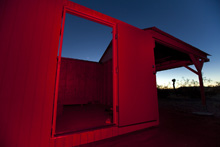CaliforniaStars Observatory
An observatory to call one's own is the dream and goal of many amateur astronomers and astrophotographers. Since most amateur astronomers, myself included, aren't fortunate enough to live under dark skies, the alternative to a permanent observatory is lugging equipment to and from various remote locations. A permanent observatory provides a consistent environment with equipment that's already aligned and ready to go every night. No more hauling heavy equipment from site to site, aligning, tearing down, and hauling it all back home. It also makes long-term imaging projects much more feasible.
The observatory is located in Landers, California, at the dark sky site of the Riverside Astronomical Society. The Goat Mountain Astronomical Research Station (or GMARS), as it's known, is located in relatively dark skies between Johnson Valley and the town of Yucca Valley. It's not an ideal location for astrophotography but it's much better than trying to do it from home and it's much less expensive than setting up a remote observatory in New Mexico, Arizona, or Australia.
In 2017, I acquired a second observatory at GMARS. As of late 2018, I completed converting the second structure to a dedicated, remotely-operated observatory while the original structure is now a warm/cold room from which I can control the observatory while I'm on-site. The observatory can also be fully operated remotely from anywhere with an Internet connection.
- Observatory Details
- Size: 10' x 12'
- Design: Roll-off roof based on the Sky Shed basic plan (modified over time by RAS members)
- Construction: Concrete raised foundation (perimeter only), 2x6 floor joists, 3/4" plywood subfloor, standard 2x4 wall studs covered with 5/8" T1-11 siding, corrugated galvanized steel roof
- Remote operation capabilities: Full remote operation capable
- Timeline:
- Major construction start: March 27, 2010 (trench and forming for concrete foundation and pier hole)
- Major construction end: May 9, 2010 (foundation, subfloor, framing, siding, outriggers, and roof complete)
- Fully operational: September 19, 2010 (installation of the mount, telescope, and supporting electronics)
- Site Details
- Location: Landers, California (34° 17' N, 116° 23' W)
- Nearby towns: Yucca Valley (12.5 miles SSW; population 21,000), Joshua Tree (11.5 miles SSE; population 7,500), Twentynine Palms (21.7 miles SE; population 31,000)
- Elevation: 2,940 feet
- Climate: Southern California high desert–Minimum temperature around 20-30°F (Dec-Feb). Maximum temperature around 100-115°F (Jul-Aug). Low humidity. Winds are common. Thunderstorms are somewhat common in the summer months. Any amount of snow is unlikely but still possible during the winter months.
- Seeing conditions: Typically 3 arcseconds FWHM or worse with occasional periods of better seeing.
- Darkness: Average SQM reading of 21.42, which is equivalent to a NELM of 6.3 at the zenith.







